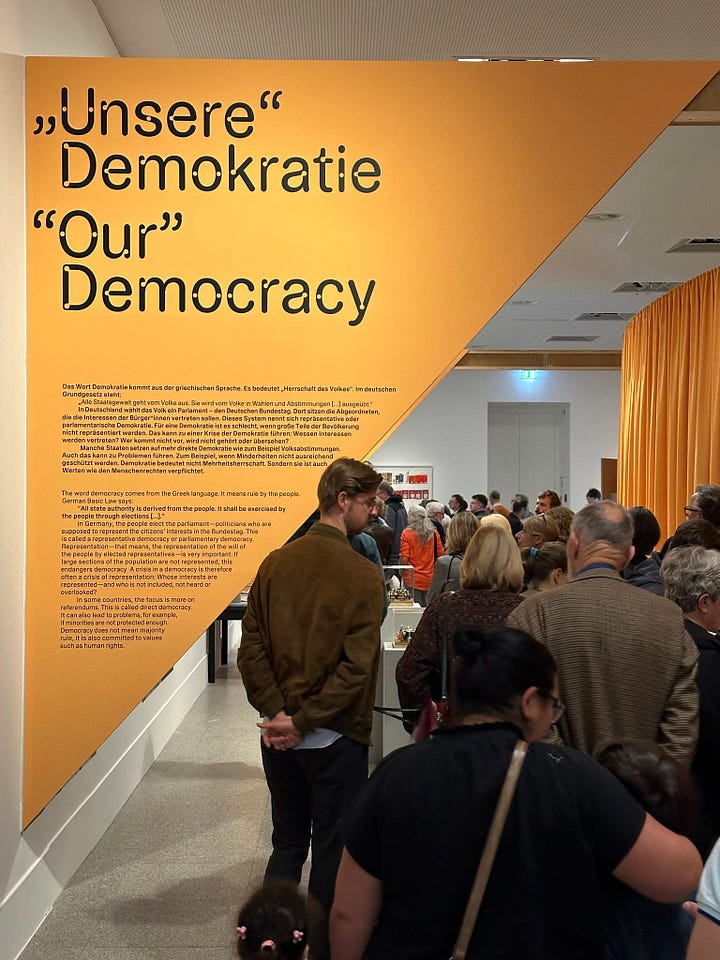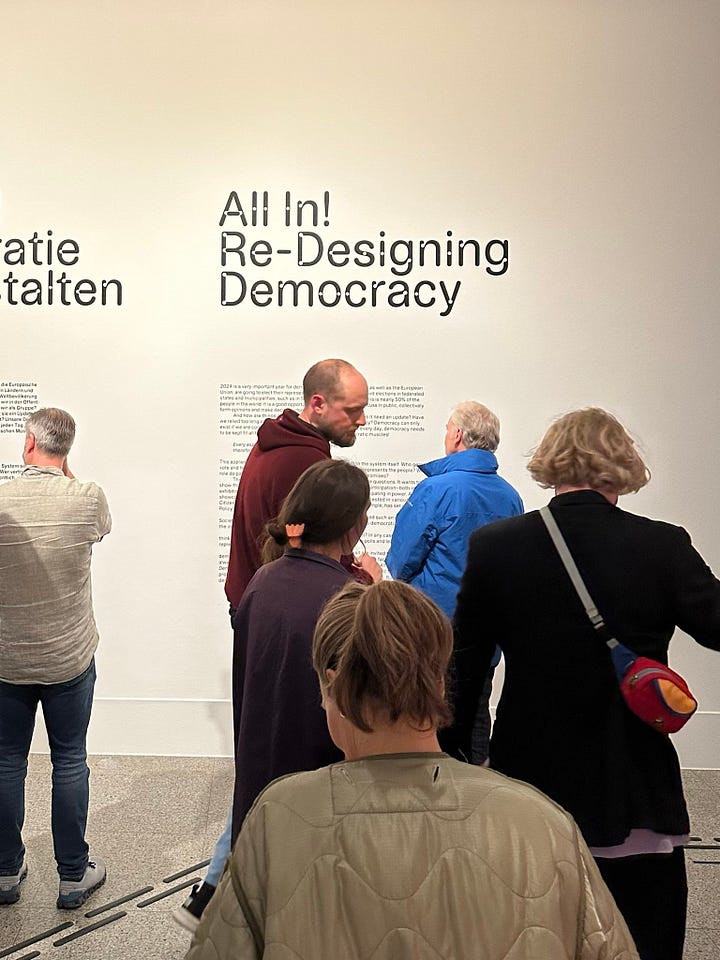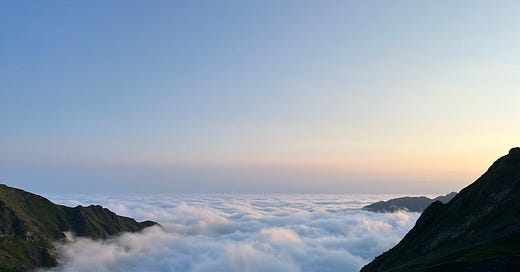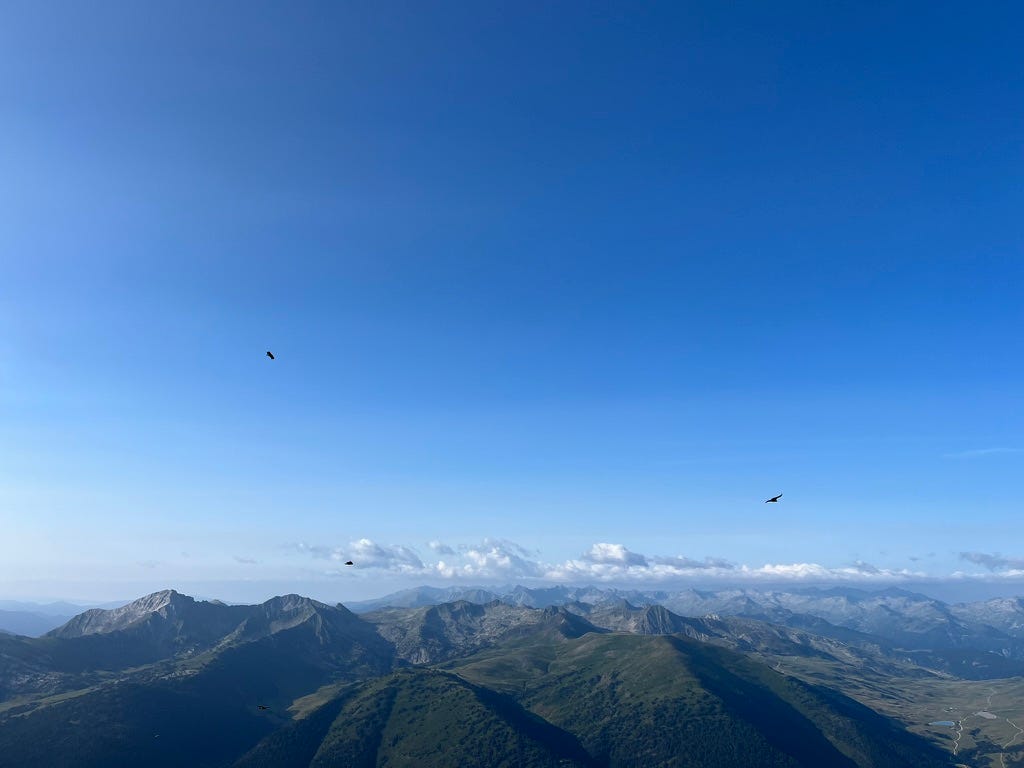⛰️ Governing with the more-than-human world
What does this mean, why should we care, and how could we do this in practice?
It’s 5.30 a.m. and I can hear rustling outside our tent. Our guide is gently getting up our small group. It’s cosy in the sleeping bag, but the excitement of another day’s adventures means I’m alert and getting dressed quickly. I unzip the side of my tent. The grass is covered with pearls of water. I can smell it. A mist hangs low amidst the soft morning light. Stepping outside, I now see that we’re just above a sea of clouds, where yesterday we could see into the valley below.
Turning around, I examine the peak we will start with this morning while the air is fresh. An 800m climb up to just above 3,000m of altitude. It’s not a path that’s marked on the maps. Our guide is from the region and knows the hills like the back of his hand. There is a certain thrill to discovering the wilder places outside the well-marked paths.
After having some breakfast, coffee, and packing up our camp, I go down to the river to wash my face and fill up my water bottle. Ready, we set out on our climb. There is not another human in sight in all directions. Only our group of six and the birds chirping.
Over an hour later, we reach a ridge that opens up a view to the other side. We are technically in France, and a few steps away is Spain. The wind is fiercer without the protection of the mountain side, but it makes me feel alive. Only 200m left to the top.
The promise of 360 views is one of the motivations of many mountain lovers. There is another kind of wonder that emerges when a real effort has been demanded to get that view as well. I can now see the vastness of the sea of clouds. The wind is even harsher here.
“Look!” Our guide points us to a first vulture that flies past. There’s a second, and a third, and fourth. There were around fifty vultures that flew together that morning. An amazing sight that stopped us all in our tracks, mesmerised. It has remained the only time in my life that I’ve witnessed a wake of vultures like that. There was no way my phone camera could capture this moment; they were all around us in all directions. I put it away and watched them, the memory strengthened in my mind.
I’ve been working on questions of governance and democracy for well over a decade. It’s only been in the past four years that I would say my own relationship with the natural world has shifted—when, in a moment of personal crisis, I sought solace in the hills and forests. It was around this time that I met my now dear friend and DemNext Board Chair Robbie Stamp, who offered me The Spell of the Sensuous by David Abram, setting me down an intellectual journey. This paper and wider project is part of that path.
For a long time I saw my personal interests and experiences in the mountains as separate from my intellectual work on democracy. It’s only recently I’ve started to see the threads and connections between the two. I had an ‘aha’ moment when someone asked me “Why do you talk about your love of nature so much?” in a professional setting last year, where I realised that I was even doing that. It prompted me to write a first essay on “more-than-human democracy” that flowed out of me.
As I started writing, the connections suddenly seemed obvious. Our relationship with the living world comes forth in questions about belonging, connection, borders, citizenship, time, place, and community. These are all the foundations behind ‘democracy’, upon which our institutions, practices, and rituals get formed. Without a solid foundation, we cannot have a solid democracy.
At a time when there is widespread consensus about ‘democracy in crisis’ all over the globe, going back to the fundamentals about agency, trust, connection, belonging, curiosity, and other relational elements is essential. Expanding that beyond the human-centric lens to recognise we are in relationship not just with each other but with the living world - that we are not separate to it, but a part of it - is equally essential.
Going back to the mountaintop for a moment, when you are straddling what are two different countries, surrounded by nothing but wind, seas of clouds, vulture wakes, and mountain peaks in all directions, you suddenly feel like a very tiny part of this immense planet. It makes me think about borders in new ways. It’s in those moments I feel most grounded and part of something bigger than myself.
What does this mean then for innovations in governance? What would it entail to govern with, not just for, the living world? The answers to these questions are not obvious to me. People sometimes bring up caricatures like placing a plant at the deliberation table. That is clearly far from the answer! But what is a thoughtful approach to more-than-human governance? What could it mean, in practice, to experiment with such approaches? These are the questions that are at the heart of this initial discussion paper, and are at the heart of DemocracyNext’s project on more-than-human governance.
In conducting research on these issues, I’ve interviewed practitioners, lawyers, theorists, designers, artists, and others who are experimenting with different approaches. From interspecies councils to legal approaches that give new rights to elements of the natural world and animals, to artistic practices that create embodied experiences of new governing relationships, and other examples, there has been a richness in imagination about how to approach these questions…
Read the rest of Claudia Chwalisz’s exploratory paper (PDF) on more-than-human governance on our website →
DemocracyNext and Arising Quo will publish a follow-up paper this summer going into greater depth, as well as the learnings emerging from our convening next month in the Netherlands.
This paper is intended to serve as as starting point for an ongoing conversation. Please feel free to get in touch with any ideas, comments, or additional examples: claudia@demnext.org




The first exhibition linked up to DemocracyNext's collaboration with Design & Democracy, the Bundeskunsthalle (Art and Exhibition Hall of the Federal Republic of Germany), and the Dresden Kunstgewerbemuseum / SKD (Decorative Arts Museum) has just opened at the Bundeskunsthalle in Bonn, Germany — with ample turnout from the public!
The exhibition asks: “Does our democracy need an update? Have we relied too long on the fact that nothing can shake our democracy? Democracy can only exist if we are constantly working on it. In a world that changes every day, it needs to be kept fit all the time. So, it's time to strengthen our democratic muscles!”
Last fall, the museum empowered 35 randomly-selected citizens over four days of deliberation, called the Bundeskunsthalle's Society Forum, to help democratise the museum.
For more, see this edition of our newsletter or visit the Bundeskunsthalle exhibition’s webpage. ALL IN! RE-DESIGNING DEMOCRACY will run until October 13.
🔮 What is “Future Design”?
“Future Design uses role play and imaginary future generations to help groups improve their capacity for empathy and creative problem solving, and to better account for the needs of both current and future generations,” according to a new paper by researchers Suzette Brooks Masters and Karthick Ramakrishnan.
This kind of thinking could be useful for Citizens’ Assemblies, and perhaps already takes place in many of them. To learn more, watch this panel event, including a presentation by Tatsuyoshi Saijo, CEO of Japan’s Future Design, hosted by our friends at KNOCA:
DemNext Founder/CEO Claudia Chwalisz will join an upcoming KNOCA event on June 11 to examine trends and opportunitites around Climate Assemblies in particular. Details and registration here.
🇨🇦 That time a national magazine convened a precursor to Citizens’ Assemblies…
In a new essay published by our Advisory Council member Jon Alexander, Rosa Zubizarreta takes us back to 1991 to remind us of a seminal Maclean’s Magazine special issue on the future of Canada. There were significant divisions and uncertainty at that time about Quebec and other big questions, so the magazine convened a panel of 12 diverse members of Canadian society to consider those questions collectively, then published a deep dive into what happened. We’d love to see more media organisations today follow Maclean’s example! Read more here.
⁉️ Are Citizens’ Assemblies an undemocratic “shortcut”? Yale PhD political science student Shao Ming Lee takes on this question in a new paper published by the Journal of Deliberative Democracy. An excerpt:
It is very much possible that citizens understand the importance and weight of the duties they have been selected for and work actively to represent as many views as possible. Indeed, if the French Citizens’ Convention is any indication, where a substantial majority of 65% of the mini-public said they did not speak for themselves only (Landemore 2020: 119–120), then it is not utopian to think of lottocratic citizen representation as genuinely representative. Norms can always develop amongst citizen representatives that they are not deliberating only on their own behalf. In any case, it seems rather strange that electing someone is seen as the only way in which decision-makers can be seen as actually representative.
As always, thanks for reading DemocracyNext’s newsletter! Subscribe and spread the word if you find our work valuable.











👉 https://www.seuil.com/ouvrage/les-formes-du-visible-philippe-descola/9782021476989
👉 https://www.ucpress.edu/book/9780520276116/how-forests-think
👉 https://www.editionsladecouverte.fr/face_a_gaia-9782359251081
“The unit of survival is *organism* plus *environment*. We are learning by bitter experience that the organism which destroys its environment destroys itself.”
Gregory Bateson
GAIA 🔄
Thank you Bernie!